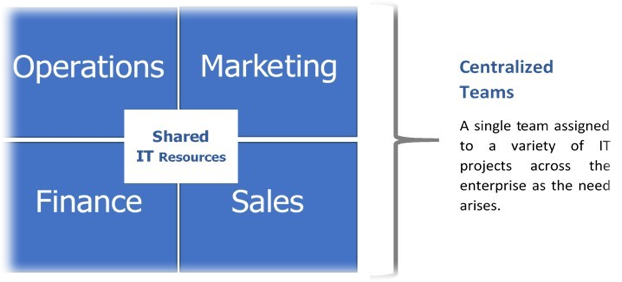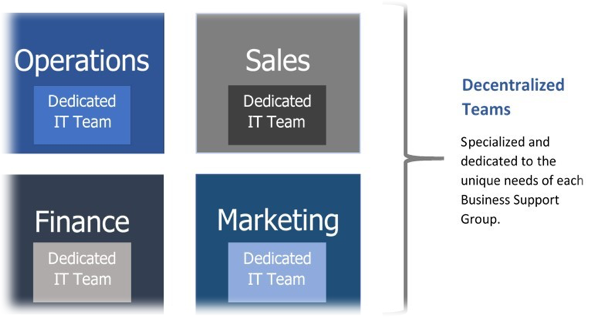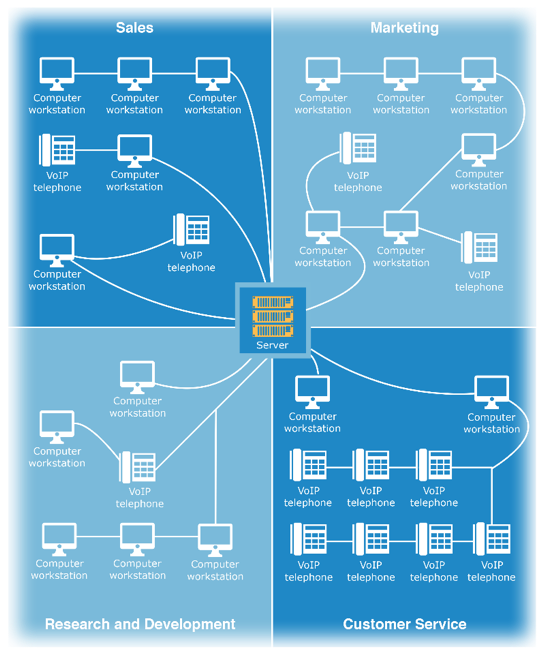Centralized vs. Decentralized IT Teams – What’s the difference?
Centralized teams vs. decentralized teams is a topic that’s moved past water cooler “buzz” nearly 3 years ago, and into actual implementation – for IT teams, there’s more at stake than realignment of personnel. In this 4 part series, we’re breaking it down to provide you a complete picture of the good, the bad, and the ugly depending on your unique perspective.

McKinsey recently re-released a report from 2011 on the pros and cons of decentralization vs. a centralized organization. VMWare and Vanson Bourne researchers also completed a study at the end of 2016, which revealed that over the past 3 years 69% of the participating businesses agreed there was an accelerated effort to decentralize the IT team. In stark contrast to the trend, 65% of IT respondents prefer to be more centralized. It’s an interesting juxtaposition, which requires each business to consider their long-term business vision, financial and productivity efficiencies, and the cultural impact.

The McKinsey report outlines an assessment that suggests the decision to use decentralized teams should have a financial basis, followed by a risk vs. reward analysis. The Vanson Bourne study doesn’t outline a process to determine the “right” approach, but rather reveals a more pragmatic perspective seen through the eyes of IT leaders who view the decision from a technical management, risks and productive efficiencies and/or inefficiencies to the enterprise.
To-date, there’s not a consensus on a “right-way” or “wrong-way”, we’ve placed candidates for both types of organizational models – but there’s plenty of opinions. We’ve broken down both sides to provide some perspective regarding the implications and challenges that the IT teams need to manage.
Centralized Organization

Traditionally, an enterprise has organized their IT team as a single department under the leadership of a CIO. This team works across an enterprise as various needs and projects arise, as requested by each business support group or the executive team. From an architectural infrastructure perspective, all LOBs are set up – Software Advice provides a good graphical representation. Although there are significant efficiencies from this approach, there’s also a risk to the entire organization should there be a server(s) failure, as each LOB is interconnected to a central main-frame.
According to the VM Ware study, the benefits of this type organizational structure include, but not limited to, increased purchasing power, improved information flow between IT team members, skilled talent hiring efficiencies, and an eagle’s view of the enterprise’s technical infrastructure from both an operational network and security perspective. With little to no surprise, security challenges are becoming a predominant theme in support of a centralized organizational set-up.
Other benefits of centralized IT team structure sited in the study include:
- 62% state centralization reduces hacking vulnerabilities
- 73% state cyber-attacks are not as successful
- 83% state centralization lowers overall expenses
From a business perspective, the centralized structure offers several qualifiable benefits which challenge the idea of a decentralized structure, including:
- Improved productivity for IT staff – IT teams are like any other team, they thrive with collaboration and mutual understanding and respect for each other’s skills sets. It also makes installations and technical resolution(s) easier as you’re addressing a centralized resource.
- Lowered expenses and increased purchasing power – the centralized environment will always provide a business with more buying power at a lower cost by combining all of the needs of the business into a centralized buying pool.
- Enterprise-wide information dissemination – the centralized organization will build their network from the center out – LOBs will typically share the same networked resources – such as an ERP or CRM. This avoids the dangers of siloed information that could be critical to another LOB, but without access there’s no visibility the information is available.
Despite the passionate views, a centralized team has several limitations and challenges – one of those challenges with the greatest enterprise-wide exposure – How best to prioritize submitted project requests from each of the LOBs – with 63% in agreement this is an on-going challenge. What criteria is used to determine the greatest priority? Revenue impact, operational impact, or possibly new regulations. Unsurprisingly, each business support group will consider their projects to have the greatest priority, and usually prepared to defend their position with ample support. In contrast, decentralizing the IT team and assigning technical team to each business support group, seems to eliminate the challenge of competing internal prioritization. Learn more about our thoughts on centralized and decentralized teams in the second part of this article!
CultureFit and Advance Search bring a combination of over 10 years of IT Recruitment; entrusted to hire and place IT professionals throughout the Greater Chicagoland and Milwaukee area. Each year, they’re charged to recruit, negotiate, and place 100’s of open positions with quality talent that meet skill set requirements as well as compliment an organization’s culture. Our unique position has afforded us the opportunity to identify hiring trends from both the organization and the talent’s perspective.

